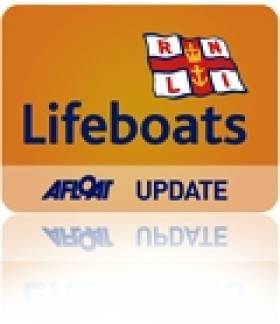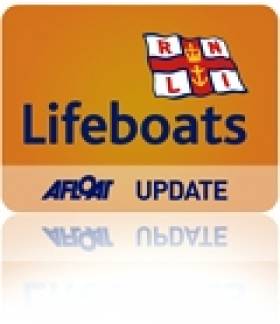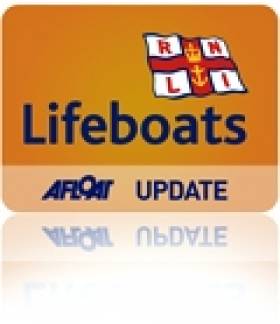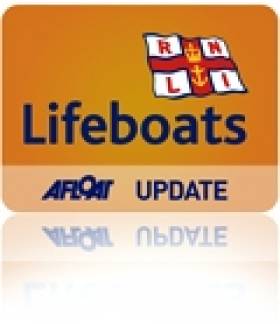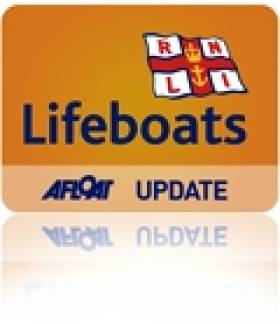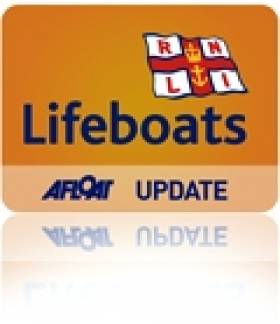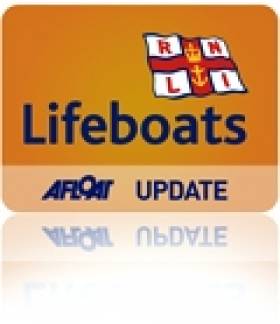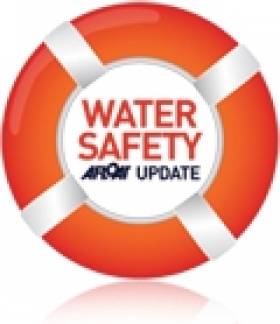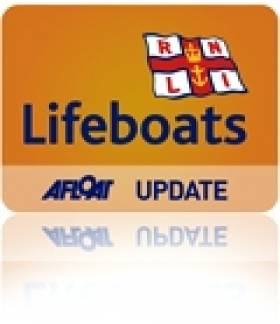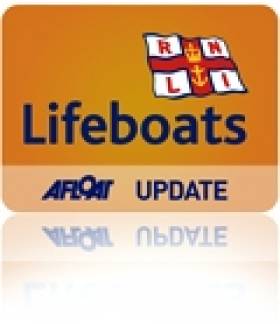Displaying items by tag: Lifeboats
Wicklow Lifeboat Tows Cabin Cruiser To Safety
#RNLI - Wicklow RNLI's second call-out this bank holiday weekend – after Friday's early morning tow of a stricken yacht - saw two on board a 13m cruiser brought to safety early today (4 May) after their vessel suffered engine failure.
The station's all-weather lifeboat was launched at 6.44am and located the vessel a short time later, two miles east of Wicklow Harbour.
Volunteer crew member Terry Sillery went on board the motor cruiser to assist with establishing a towline.
Weather conditions in the area at the time were blowing a westerly force three wind and there was poor visibility.
The motor cruiser was on passage to Wales when it developed engine trouble. The owner put down an anchor so the vessel would not drift and contacted the Irish Coast Guard for assistance.
The stricken motor cruiser was towed into Wicklow Harbour and safety secured alongside the East Pier at 7.40am.
The crew on the call-out were coxswain Dave O'Leary, mechanic Tommy Murphy, Terry Sillery, Carol Flahive, Brian Sinnott, Connie O'Gara, John Vize and Alan Goucher.
#RNLI - Wicklow RNLI launched in the early hours of yesterday morning (Friday 2 May) to bring a yacht and its crew of three to safety.
The volunteer crew launched their all-weather lifeboat at 2.57am in response to a call for assistance from an English yacht with three people on board some 23 miles north-east of Wicklow Harbour.
The alarm was raised after the skipper of a yacht contacted the coastguard to say he was unable to make any headway due to insufficient wind, and was having difficulties after the boat’s engine had failed.
The lifeboat, under the command of coxswain Tommy McAulay and five volunteer crew members, located the vessel at 4.20am. A towline was passed and the casualty was towed into Wicklow Harbour, arriving safely at 6.55am.
Speaking following the call out, Wicklow RNLI lifeboat operations manager Des Davitt said: "Our volunteers are always on call and prepared to respond to any emergency at any time.
"We were delighted to be of assistance at this early hour and were glad to be able to bring these three people and their yacht safely to shore."
The lifeboat crew on the call out were coxswain Tommy McAulay, mechanic Brendan Copeland and crew members John Vize, Tommy Murphy, Connie O Gara and Alan Goucher.
Rescued Sailors Join Kinsale RNLI Mayday Campaign
#RNLI - Crew members from the training ship Astrid that sank on 24 July 2013 visited Kinsale RNLI lifeboat station to thank volunteer crew and support the RNLI’s Mayday campaign.
Some 30 young people were brought to safety by RNLI lifeboat Miss Sally Anne Baggy when the tall ship hit rocks between Oysterhaven and Kinsale.
Volunteer crew members Liam O’Connell, Nick Searls and Jim Grennan, who were on the Kinsale RNLI lifeboat on the day Astrid sank, were on hand to welcome the visitors and present them with iconic Yellow Welly key rings to mark the occasion.
Undeterred by their experience last summer, the youngsters were taking part on a training exercise on 70ft schooner Spirit of Oysterhaven, the flagship of The Oysterhaven Centre.
The Astrid rescue was just one of more than 40 rescue missions launched by Kinsale RNLI last year.
Voice of Ireland judge and former Westlife member Kian Egan has lent his support to the Mayday campaign which runs from this Thursday 1 till Monday 5 May, when the charity’s volunteers will be selling yellow welly pin badges and key rings for a €2 donation, in cities, towns and villages throughout Ireland.
And as previously reported on Afloat.ie, there will also be a number of welly-themed events held to raise funds for the lifesaving charity in Ireland.
Skerries Lifeboat Rescues 3 From Grounded Fishing Vessel
#RNLI - Skerries RNLI rescued three men last night (Thursday 24 April) after their 30-foot fishing vessel ran aground on rocks north of Balbriggan harbour in extremely poor visibility.
The volunteer crew launched their inshore lifeboat shortly after 9pm with Rob Morgan as helm and crew members Emma Wilson, Stephen Crowley and Laura Boylan also on board.
The Dublin Coast Guard requested the lifeboat to launch after receiving of reports that a vessel had struck rocks north of Balbriggan harbour. The lifeboat proceeded directly to the area indicated.
Conditions on the night were calm with a force one southerly wind, though there was a thick sea fog in the area at the time and visibility was reduced to 1-2 metres.
Clogherhead RNLI's all-weather lifeboat also launched at 10pm after Skerries RNLI requested their assistance, given the possibility that a long and difficult search may have been necessary. Coastguard helicopter Rescue 116 and the Skerries coastguard ground unit were also tasked.
Communication with the vessel in distress was established through another fishing vessel. Along with the information relayed from the vessel, the volunteer crew used the radar and direction finder on board their Atlantic 85 inshore lifeboat to pinpoint the casualties location.
The three men were taken on board the lifeboat where they were assessed and did not require any medical attention.
Clogherhead RNLI, Skerries coastguard and Rescue 116 were all stood down as Skerries RNLI returned the three men to the lifeboat station, where they were reunited with waiting family members.
Speaking after the call-out, Skerries RNLI helm Rob Morgan said: "Visibility was extremely poor out there this evening. The volunteers training really paid off, particularly with the radar and VHF direction-finding equipment. Thankfully we found them in time and it was a good result."
‘Give It Some Welly’ For The RNLI This Mayday
#RNLI - The RNLI is calling on the public to ‘give it some welly’ and support Mayday, the charity’s major fundraising campaign in Dublin.
People are being asked to buy and wear a yellow welly pin badge or keyring which they can buy for €2 or hold a welly-themed event to raise funds for the lifeboats in their communities.
The yellow welly is an essential piece of RNLI crew kit. Waterproof with steel-capped toes, the specially designed boots keep the volunteer crew’s feet warm and dry while also protecting them in dangerous conditions on deck.
During gale force winds, rain and ice, keeping a sure footing can mean the difference between life and death for the volunteers.
A pair of yellow wellies for a volunteer costs €50. and supporting the RNLI’s Mayday campaign and buying a yellow welly keyring or pin badge will cost just €2.
Mayday will run from next Thursday 1 to Monday 5 May, with yellow welly keyrings and pin badges being sold by volunteers in locations around Dublin.
Badges and keyrings will be on sale in Dublin city centre on Thursday 1 May and Saturday 3 May, and will also be available at Northside Shopping Centre, Dundrum Town Centre and at selected train stations.
A special Yellow Welly Fare Day is also being held in Skerries in North Co Dublin on Sunday 4 May.
Volunteer lifeboat crew have responded to the Mayday calls of those in distress around Ireland’s coastline for 190 years. Lifeboat crew members who are on call 24/7, 365 days a year have spent an average of 137 hours at sea over Mayday weekends for the last 10 years.
Most have a full-time job, but they carry a pager and, when it goes off, they rush to the lifeboat station and launch the lifeboat to rescue those in danger.
Last year RNLI lifeboat stations in North and South Dublin launched 124 times and brought 158 people to safety.
Supporting Mayday, Howth RNLI crew member Ian Sheridan said: "We are delighted to be supporting the RNLI’s Mayday campaign. Each time our lifeboats launch in Howth, it is only possible through the generosity of the public.
"Callouts can range from a sinking yacht to an overdue fishing boat or a swimmer in trouble. Every call is important and could potentially be a life saved."
Skerries RNLI volunteer lifeboat crew member Gerry Canning added: "I am one of 1,500 volunteer crew members in Ireland and each of us receive valuable crew training, equipment and kit.
"We rely on the support and the generosity of the public to ensure the lifeboat crews based in Dublin and around Ireland can continue to save lives at sea."
Dun Laoghaire RNLI volunteer crew member Dave Farrell said: "Our lifeboat station in Dun Laoghaire is busy all year round and we train for every type of emergency.
"The RNLI Mayday appeal will help the charity raise funds for volunteer lifeboat crew so they can continue carrying out life-saving work."
RNLI community fundraising manager Pauline McGann added that the RNLI "is celebrating its 190th anniversary this year and during that time 144,000 lives have been saved by the charity.
"For some ideas on how to get involved and to see what is going on in your area please visit rnli.org/MAYDAY or call us on 01 895 1837. You can also show your support on social media by sharing your fundraising photos and using the hashtag #YellowWelly."
People can also support the campaign by texting Welly to 50300 to donate €4 – 100% of the text cost goes to the RNLI across most network providers. Some providers apply VAT which means a minimum of €1.63 will go to the RNLI. Please ask permission from the bill payer before you text.
Donaghadee Lifeboat Rescues Crew On Becalmed Yacht
#RNLI - Donaghadee RNLI rescued a yacht and crew when they became becalmed in the Irish Sea on Good Friday last.
The Co Down coastal town's all-weather lifeboat Saxon was at sea within 10 minutes of the request for assistance from the coastguard at 3.47pm.
At the scene, close to South Rock south of Portavogie, a tow line was established to the 31-foot vessel that had suffered engine failure and was unable to make headway by sail in the calm conditions.
The yacht was towed to Donaghadee in an operation lasting more than two hours. The lifeboat was then stood down at 6.05pm.
Lifeboat coxswain Philip McNamara said: "While this was a preventative operation, the lifeboat volunteers prefer to attend at an early stage to avoid any risk to life should weather conditions change or the light should fade.”
#RNLI - Red Bay RNLI's lifeboat launched on service early on Easter Sunday morning to go to the aid of a support boat with two people on board near Glenarm, Co Antrim.
The boat had suffered engine failure and was driven ashore by the wind and swell.
The Red Bay RNLI lifeboat launched at 9.20am and the crew subsequently rescued the two people from the vessel before towing the boat clear of the rocks. No one was injured in the incident.
The boat is now in Glenarm Marina. The lifeboat returned to station at 11.00am. The operation was co-ordinated by the Belfast Coastguard.
#WaterSafety - The crew of Bundoran RNLI's lifeboat, together with local fishermen and members of Irish Water Safety, recently welcomed a group of students from Lucan, Co Dublin who created a new school’s guide to water safety in Ireland’s rivers, lakes and seas.
The group of students from St Joseph’s College in Lucan are participating in the 2014 Young Social Innovators programme and were tasked with picking an issue of concern in their local area and to take action to change it for the better.
They decided to tackle the ongoing problem of drowning, particularly after the tragic summer last year when so many young people lost their lives needlessly during the hot spell.
Their vision for the information pack is to “think before you splash” – encouraging young people to become more involved in water activities and to increase their awareness of the water.
The pack consists of a lesson plan for teachers as well as a local ecology & water safety survey, 10 water safety rules and more.
Speaking during the visit, Bundoran RNLI crewmember Killian O’Kelly said: "It’s heartening for us who volunteer to save lives at sea to see this initiative being undertaken so enthusiastically by this group of students – they are to be commended for such an excellent piece of work and if it helps to save one life this summer then it’s time well spent."
The group hope to make the booklet available online in the coming weeks.
More Honours For Kinsale Lifeboat Crew Over 'Astrid' Rescue
#RNLI - Last Friday (11 April) was a busy night for the volunteer crew of Kinsale RNLI as they collected two West Cork community awards for bringing to safety the 30 crew members of the training ship Astrid that sank outside Kinsale harbour in July last year.
The first honour of the night was bestowed at the 25th anniversary awards ceremony in Bandon’s Munster Arms Hotel, organised by The Opinion magazine and sponsored by Bandon Co-op.
Kinsale lifeboat Miss Sally Anne (Baggy) was first on the scene on 24 July 2013 when the Astrid ran aground. Volunteer crew members Liam O’Connell, Nick Searls and James Grennan worked in treacherous conditions to safely evacuate all 30 crew on board.
They accepted The Opinion/Bandon Co-op Community Award on behalf on the RNLI, along with volunteers from Courtmacsherry RNLI who assisted the rescue.
Next stop was Acton's Hotel for the Kinsale District and Community Awards. Flanked by boat and shore crew and volunteers from the fundraising team, Liam, Nick and James accepted their second trophy of the night.
Lifeboat operations manager John O’Gorman said: “This is a great honour for all the volunteers of the RNLI who give freely of their time to save lives at sea. As volunteers, our only reward is the satisfaction of a job well done and the respect of our community. We have received that in abundance tonight."
This brings to three the number of awards related to the Astrid. Earlier this year the Irish Cruising Club presented Kinsale RNLI with the Waterford Cup, a perpetual trophy dating back to 1953.
Donaghadee Lifeboat Rescues PWC Rider From Rocks
#RNLI - The volunteer lifeboat crew from Donaghadee RNLI rescued a personal watercraft (PWC) enthusiast from rocks near Millisle in Co Down on Saturday evening (12 April).
A member of the public reported the craft in difficulty south of Millisle lagoon and the RNLI responded to a request for assistance from the coastguard.
The Donaghadee all-weather lifeboat Saxon was at sea within 10 minutes at 7.20pm.
At the scene, the lifeboat crew deployed a small inflatable off the lifeboat, with two crew members aboard, and the PWC with one person aboard was helped off the rocks.
The craft was then towed to a slipway and the lifeboat stood down at 8.20pm.
Donaghadee RNLI lifeboat operations manager Alan Couser said: "If you are planning to visit the coast over the Easter holidays, make sure you check the sea-worthiness of all small craft and that safety equipment is working properly."


























